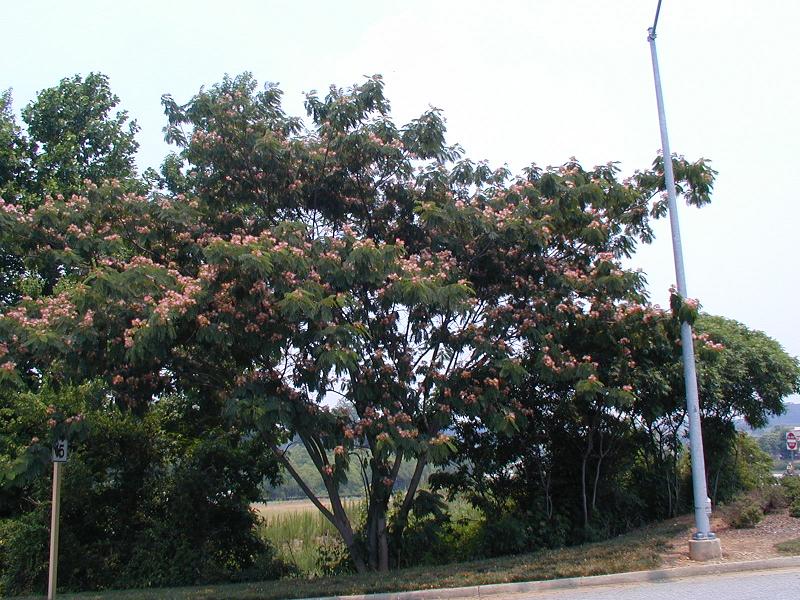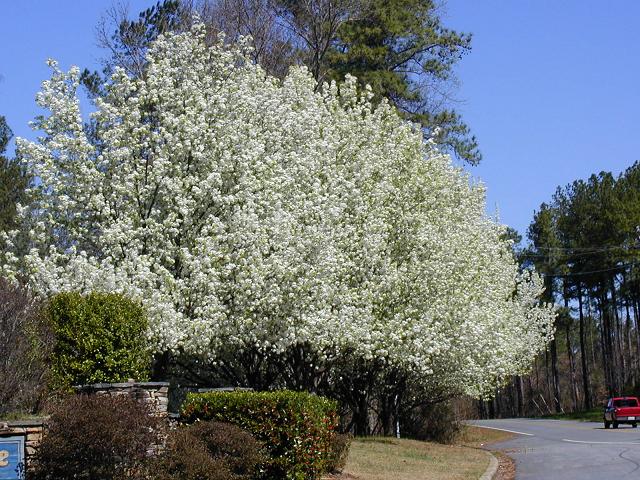Ask An Arborist: February 18, 2010

|

|
|
Mimosa Tree |
Bradford Pear |
Earning the label as a trash tree can vary from person to person based upon their experiences with planting, growing or
removing certain trees. For example, some trees are non-native invasives, while others may be well-behaved but messy, weak-wooded,
improperly suited for our climate and soil or prolific seeders (as in the case of some natives). Often the only criterion to earn
a tree the dubious distinction of being trash is that it was simply planted in the wrong location for its size or habits. For
the purposes of this article, I've divided the sections into the non-native invasives, non-natives that have other problems and
finally natives with some less-than-lovable traits.
Non-Native Invasive Trees
East of the Mississippi and in particular in Georgia we have some trees not native to North America that have been brought here
and simply have worn out their welcome. These trees reproduce so aggressively that they have the capability of out-competing
native trees or shading out native plants in certain ecosystems. I usually don't get much disagreement on this list, especially
from those who have dealt with these trees or their offspring from nearby locations.
These include but are not limited to:
- Mimosa (Albizia julibrissin): Also afflicted by a lethal Fusarium vascular wilt
- Tree of Heaven (Ailanthus altissima)
- Princess Tree (Paulownia tomentosa): Also has weak wood
- Bradford Pear (Pyrus calleryana 'Bradford'): Also has weak wood
- White Mulberry (Morus alba): Not to be confused with our native Red Mulberry
- Chinese Tallow or Popcorn Tree (Triadica sebifera)
- Chinaberry (Melia azedarach)
You can see a more comprehensive list of non-native invasive plants, including additional trees at this
web site.
Non-Native Trees with "Other" Problems
We have plenty of well-behaved non-native trees that are completely garden-worthy and then we have some that, in my opinion, have
problems that either warrant special placement, an understanding gardener or are best avoided.
These include but are not limited to:
- Ginkgo (Ginkgo biloba): Female trees (only) produce a messy, smelly fruit
- Ornamental Cherry (Prunus spp.): Unhappy in acidic, compacted clay soil; short-lived.
- Peach (Prunus persica): Healthy trees & fruit require frequent spraying.
- Golden Raintree (Koelreuteria paniculata): Attracts a boxelder-like bug by the thousands.
- Crape Myrtle (Lagerstroemia indica): Overused and often improperly maintained; Japanese Beetles.
- Fir & Spruce (Abies spp. & Picea spp.): Most are better suited to cold climates; short-lived here.
- Leyland Cypress (x Cupressocyparis leylandii): Diseases, pests, lack of drought tolerance.
Of course, many people can tolerate some of these shortcomings because they like that particular tree.
Native Trees with Undesirable Traits
I will say straight up that I'm more willing to tolerate the less-than-desirable traits of a native tree than I am of non-natives
that may be less annoying. Of course, this may be because I'm biased towards native plants or that I have enough landscape room
to let a lot of native trees do their thing farther from the house and driveway. However, some do have some really bad traits that
make them candidates for removal.
These include but are not limited to:
- Sweetgum (Liquidambar styraciflua): A handsome tree but whose gumballs are a pain; prolific seeder.
- Redbud (Cercis canadensis): A prolific seeder.
- Silver Maple (Acer saccharinum): Similar to Bradford Pear with its weak wood.
- Hackberry (Celtis occidentalis): Weak wood, messy with fruit and limb drop.
- Persimmon (Diospyros virginiana): Like the Ginkgo, female trees (only) have messy fruit.
- Boxelder (Acer negundo): Female trees (only) attract boxelder bugs by the thousands.
- Crabapple (Malus angustifolia): Messy fruit.
- Pine (Pinus spp.): Often mistakingly maligned for being weak; do produce tons of needles.
Often these trees are tolerable if they aren't too close to active areas
of your landscape or the house.
I would love to get your opinion of trees that you think should be added
or removed from the trash list. Please email me your list of trash or non-trash trees.
If you are concerned about the trees in your landscape, you can contact a Certified Arborist or a professional tree company in
your area through the web site of the
Georgia Arborist Association.
Unless otherwise noted, Images & Drawings Copyrighted © 2010 by Theresa Schrum - All rights reserved



